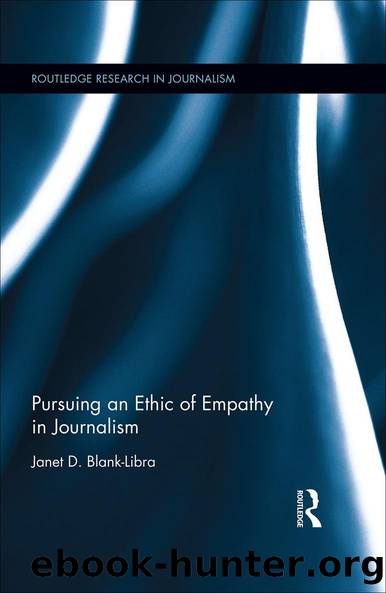Pursuing an Ethic of Empathy in Journalism by Janet Blank-Libra

Author:Janet Blank-Libra [Blank-Libra, Janet]
Language: eng
Format: epub
Tags: Social Science, Media Studies, Language Arts & Disciplines, Journalism, Communication Studies
ISBN: 9781317272281
Google: LW19DAAAQBAJ
Publisher: Routledge
Published: 2016-06-23T03:23:23+00:00
Nellie Bly
In 1887, John Cockerill, managing editor of Joseph Pulitzerâs New York World, hired Nellie Bly to feign insanity so that she could be committed to Blackwellâs Island Insane Asylum in order to reveal its horrors with details gathered during 10 days of firsthand observation. Blyâs (1887) work, âTen Days in a Mad-House,â reflects the desire of the publisher to sell papers and the desire of the reporter to play a role in the pursuit of justice. Her work reveals, as well, a reporter who both did and did not understand that empathy could lead to accurate, deep representations of individuals and groups. Both in âTen Days in a Mad-Houseâ and in âSix Months in Mexico,â less so in the first than in the second, Bly made public the heart and mind of a writer influenced, as were Riis and Crane, by her own biases and despite her best intentions. She did not fully understand how an ethic of empathy could function constructively.
To some degree Blyâs âTen Daysâ reflects the principles laid out by empathy theorists today. She was not influenced by the stereotype of the âcrazy woman.â Rather, she was open to the possibility that some, perhaps many, of the women were sane. Rendered invisible in a society that had yet to be influenced by the vision and courage of the suffragettes, these womenâs lives illustrated the worst kind of oppression: they had been disempowered and dehumanized by their fellow human beings, often for the sin of diverging from behavioral norms of the day.
If she possessed biases against these women, she apparently found a way to disable them, perhaps through her ability to empathize as a woman who understood the elusive nature of fairness and justice. Though not perfectly so, she does give to the women she meets in the asylum as authentic a voice as they were likely to get at the time. Her story offers rich detail that takes the reader into the lives of the women. Hearing Blyâs voice, we understand that she has listened for the verbal and the nonverbal, for the subtleties and the concrete details that could actually inspire reformâthe ultimate empathetic and compassionate act.
The reader comprehends Blyâs ability to be open to others as she witnesses a conversation and describes a scene in which a woman named Miss Tillie Mayard asks a doctor why she has been committed to the asylum. Their conversation goes as follows:
âHave you just found out you are in an insane asylum?â asked the doctor.
âYes; my friends said they were sending me to a convalescent ward to be treated for nervous debility, from which I am suffering since my illness. I want to get out of this place immediately.â
âWell, you wonât get out in a hurry,â he said, with a quick laugh.
âIf you know anything,â she responded, âyou should be able to tell that I am perfectly sane. Why donât you test me?â
âWe know all we want to on that score,â said the doctor, and he left the
Download
This site does not store any files on its server. We only index and link to content provided by other sites. Please contact the content providers to delete copyright contents if any and email us, we'll remove relevant links or contents immediately.
| Publishing & Books | Research |
| Writing |
Asking the Right Questions: A Guide to Critical Thinking by M. Neil Browne & Stuart M. Keeley(5572)
Autoboyography by Christina Lauren(5154)
Eat That Frog! by Brian Tracy(4377)
Dialogue by Robert McKee(4270)
Sticky Fingers by Joe Hagan(4059)
Journeys Out of the Body by Robert Monroe(3534)
Annapurna by Maurice Herzog(3395)
Full Circle by Michael Palin(3346)
Schaum's Quick Guide to Writing Great Short Stories by Margaret Lucke(3278)
Elements of Style 2017 by Richard De A'Morelli(3278)
The Art of Dramatic Writing: Its Basis in the Creative Interpretation of Human Motives by Egri Lajos(2942)
Why I Write by George Orwell(2849)
The Diviners by Libba Bray(2838)
In Patagonia by Bruce Chatwin(2828)
The Mental Game of Writing: How to Overcome Obstacles, Stay Creative and Productive, and Free Your Mind for Success by James Scott Bell(2816)
The Fight by Norman Mailer(2791)
Atlas Obscura by Joshua Foer(2757)
Venice by Jan Morris(2494)
The Elements of Style by William Strunk and E. B. White(2413)
